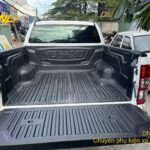Upgrading truck tires isn’t just about replacing worn parts; it’s about optimizing performance and handling. Increasingly, upsizing truck tires is a focus for many owners, especially for heavy-duty, hybrid, and electric trucks. So, when is this necessary, and what factors should we consider?
The main reason to consider upsizing truck tires stems from load capacity requirements. Since the entire weight of the vehicle rests directly on the four tires, heavier trucks require larger tires or tires with a higher load-bearing capacity. This is especially important for hybrid and electric vehicles, which tend to be heavier than traditional vehicles due to their battery systems. Upgrading tires helps ensure operational safety, preventing overloading that can cause tire blowouts or reduce tire life.
However, upsizing truck tires is not always easy and does not always offer absolute benefits. Vehicle manufacturers often design wheel wells with limited space, especially on modern sports cars and hybrid vehicles. Installing oversized tires yourself can lead to the following problems:
- Reduced aerodynamic efficiency: Wider tires create greater air resistance, reducing the vehicle’s aerodynamic efficiency. This especially affects hybrid and electric vehicles, causing faster battery drain and reducing driving range.
- Impact on steering and suspension systems: Changing tire size can affect the steering system, suspension system, and vehicle sensors. This can reduce steering accuracy, making it difficult to control and reducing ride comfort.
- Limited installation space: The vehicle’s chassis and suspension may not have enough space to accommodate larger tires. Attempting installation can cause rubbing, damage to tires, and other parts.
Currently, Extra Load (XL or EL) tires are marketed as having better load-bearing capacity. However, it should be noted that XL tires do not always meet the increasing load requirements of hybrid and electric trucks, especially as batteries become larger and heavier. While XL tires are more durable and stiffer than standard tires, the actual load capacity may not be as superior as expected in all cases.
To address this issue, the European Tyre and Rubber Manufacturers Association (ETRTO) has developed a new tire standard: High Load (HL) tires. HL tires are specifically designed to handle higher loads than XL tires, meeting the needs of modern trucks, especially hybrid and electric vehicles.
When considering upsizing truck tires, owners need to carefully consider the following factors:
- Vehicle specifications: Check the tire specifications recommended by the manufacturer and the maximum tire size that can be installed.
- Usage needs: Clearly define the vehicle’s intended use, typical load, and operating conditions to select the appropriate tire size.
- Tire type: Learn about high load capacity tires such as XL and HL to make the best choice.
- Expert advice: Consult tire specialists or technicians at reputable service centers for advice and support.
Conclusion:
Upsizing truck tires is an upgrade worth considering to increase load capacity and ensure operational safety, especially for heavy-duty, hybrid, and electric trucks. However, it is important to carefully consider technical factors, installation space, and actual usage needs to make the right decision. Choosing the right tires not only ensures safety but also optimizes the performance and lifespan of the truck.

